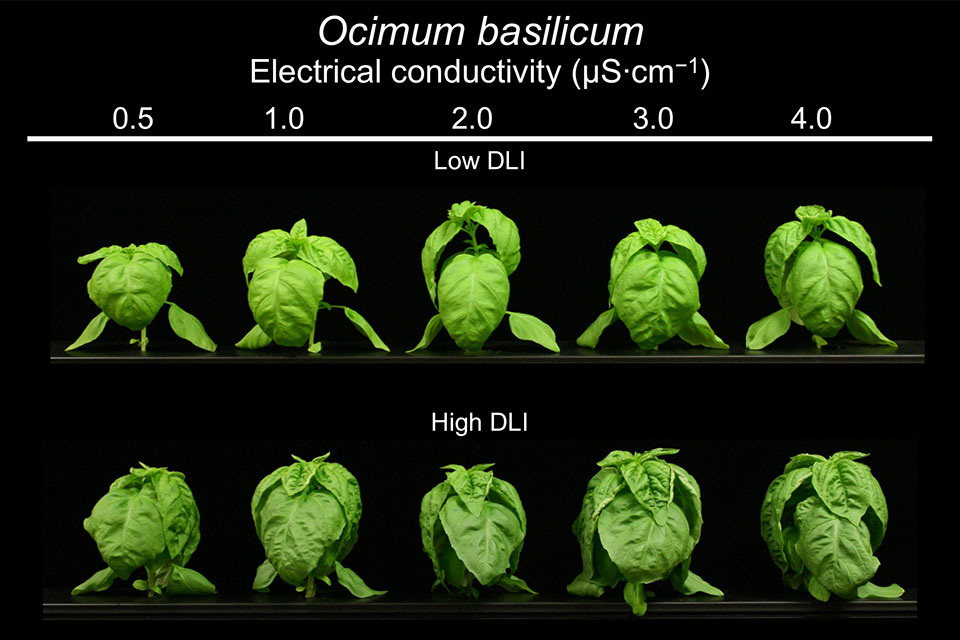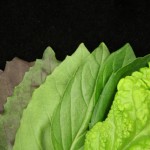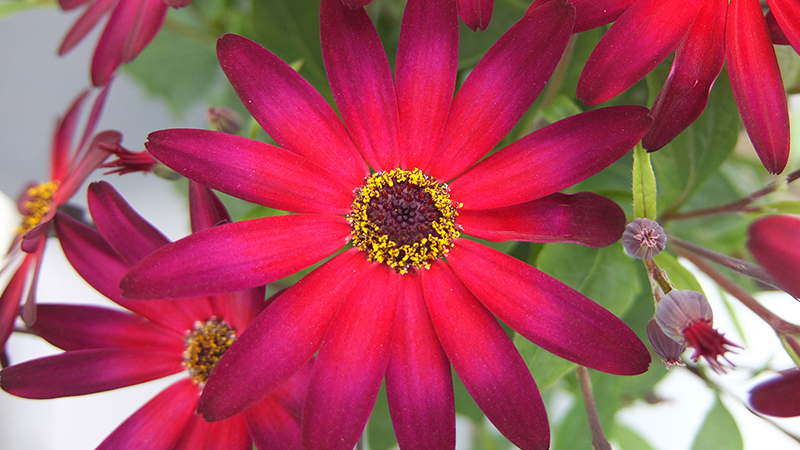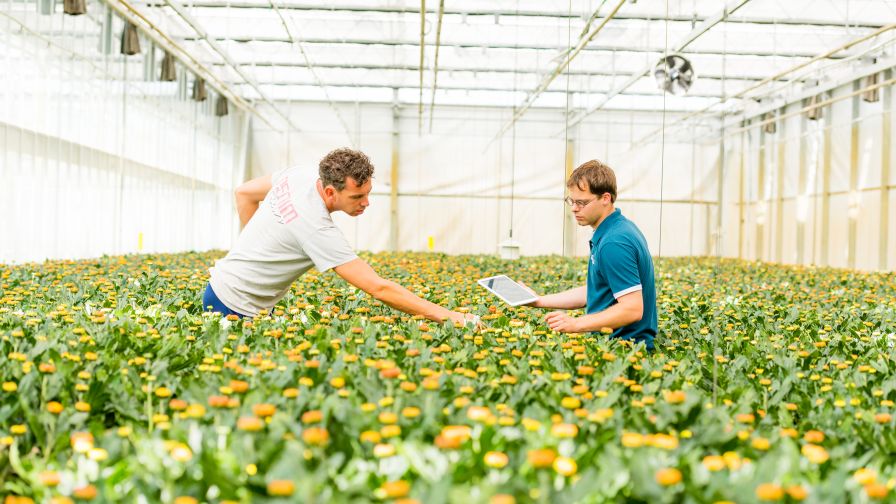Managing Electrical Conductivity (EC) For Hydroponic Basil Production
Managing nutrient solutions is one of the most important responsibilities in hydroponic crop production. When managing the concentration of nutrients, we use electrical conductivity (EC) as a guide to maintaining and adjusting our nutrient levels, trying to provide adequate nutrients and minimize excessive fertilizer use. However, what EC is required for our crops? We wanted to better understand how nutrient solution EC affects basil growth and tissue nutrient concentrations under different daily light integrals (DLIs).
In an effort to provide research-based support for hydroponic basil producers, we have been conducting a suite of research studies focused on various aspects of production. We’ve already shared our results on the effects cultivars, hydroponic systems, and planting densities have on the growth and yield of basil.
Next month, we will be looking at how temperature influences basil growth and development. However, in this article we will present research on how the nutrient solution EC affects growth and tissue concentration of hydroponic basil.
Nutrient Solution ECs And Daily Light Integrals
First, we transplanted two-week-old sweet, holy, and lemon basil seedlings into nutrient-film technique (NFT) hydroponic systems with nutrient solution EC of 0.5, 1, 2, 3, or 4 mS∙cm−1.
The nutrient solution consisted of deionized water and 16N−1.8P−14.3K fertilizer (Jack’s Hydro FeEd; JR Peters), and the ECs were maintained at their target level daily by adding concentrated stock solution or clear water to raise or lower the EC, respectively. The nutrient solution pH was adjusted to 6 daily, aerated, and circulated through a heater/chiller unit to maintain a water temperature of 72°F.
Supplemental lighting was provided by HPS (high pressure sodium) lamps to increase the light intensity during the day for the plants grown under a high DLI, and provide a 16-hour day length for plants grown under both low and high DLIs. Aluminized shade cloth was also used to decrease daytime light intensity for plants grown under a low DLI. The low DLI greenhouse was maintained at a DLI of ~7 mol∙m−2∙d−1, while the high DLI greenhouse was maintained at ~15 mol∙m−2∙d−1. Three weeks after transplanting, we measured height, node and branch number, and fresh and dry mass of shoots.
Satisfactory Growth And Nutrition Observed
Basil had comparable growth (fresh and dry mass, branches, nodes) across nutrient solution ECs and there were no significant differences (Figure 1).

Figure 1. Sweet basil grown with ECs ranging from 0.5 to 4 mS∙cm−1 under low (~7 mol∙m−2∙d−1) or high (~15 mol∙m−2∙d−1) daily light integrals (DLIs). This photo was taken three weeks after transplanting seedlings into hydroponic systems and treatments.
Although EC has no effect on basil growth, growth increased for all three basil species grown under ~15 mol∙m−2∙d−1 compared to those grown under 7 mol∙m−2∙d−1. There was no interaction between the EC and DLI on basil growth.
In addition to the growth and yield of basil, we also wanted to measure how tissue nutrient concentrations were affected by nutrient solution EC. When we looked at the nutrient concentrations, the results varied by nutrient. For example, for nitrogen, phosphorous, and sulfur, tissue concentration increased as nutrient solution EC increased from 0.5 to 4 mS∙cm−1 (Figure 2). Alternatively, calcium and magnesium tissue concentrations were lower with increasing EC.

Figure 2. Nitrogen (N) concentration of sweet basil grown with ECs ranging from 0.5 to 4 mS∙cm−1 under low (~7 mol∙m−2∙d−1) or high (~15 mol∙m−2∙d−1) daily light integrals (DLIs). Data was collected three weeks after transplanting seedlings into hydroponic systems and treatments.
What we found most interesting was that when the tissue nutrient concentrations are compared with recommended tissue concentrations for basil, the majority of values were within or above the recommended ranges, including those plants grown with the lowest EC (0.5 mS∙cm−1). For those few nutrients that were slightly below recommended values, we saw no visible signs of nutrient deficiencies and all plants, regardless of the EC, appeared healthy.
Managing Hydroponic Basil Nutrition
What are the implications of this research for managing nutrient solutions? First, the fact that most nutrients were within sufficient ranges and plants appeared healthy with no differences in yield across all of the ECs for all three species demonstrates that high-quality basil can be grown under a very wide range of ECs. This provides some opportunities and flexibility for hydroponic producers. A lower EC may help minimize fertilizer costs, whereas a higher EC may be useful to diminish the change in nutrient ratios in solution.
While not reported here, we did measure increased potassium concentrations in the nutrient solution from the beginning to the end of the production period. We attribute this increase in potassium to the potassium carbonate base we were using to increase solution pH.
Additionally, we suspect that the increased potassium concentrations may have antagonized uptake of calcium and/or magnesium. Always remember that additions to nutrient solutions such as acids or bases can add nutrients available for plants.
We were not surprised to see improved growth under the higher DLI. Previous research has reported increases in growth of up to ~500 µmol∙m−2∙d−1, so we were not surprised to see enhanced growth under the higher DLI. We were surprised to see that there was no effect of EC on basil growth. While we found that DLI affected growth, the lack of an interaction with EC to affect growth means that you do not need to change your EC as light intensity and the DLI change across seasons. While some producers lower their EC, we suspect this to be due to warmer temperatures and not higher light.
Take-Home Messages For Hydroponic Production
The bottom line is that basil grows well under a wide range of ECs. Most interestingly, basil yield, nutrient concentrations, and appearance were acceptable across ECs, even at low levels. Additionally, if there is an opportunity to increase the DLI or light intensity for basil production, basil responds very favorably to high light. Because the results may also vary across different locations, greenhouse environments, and cultural practices, as always, we encourage producers to conduct on-site trials to determine optimal nutrient-solution concentrations for the cultivars they are growing in their greenhouse environment.










